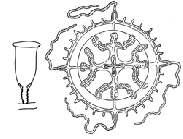Hydrozoa taxon details
Hebellidae Fraser, 1912
196237 (urn:lsid:marinespecies.org:taxname:196237)
accepted
Family
- Genus Anthohebella Boero, Bouillon & Kubota, 1997
- Genus Bedotella Stechow, 1913
- Genus Halisiphonia Allman, 1888
- Genus Hebella Allman, 1888
- Genus Melicertissa Haeckel, 1879
- Genus Scandia Fraser, 1912
- Genus Staurodiscus Haeckel, 1879
- Genus Croatella Hadzi, 1916 accepted as Scandia Fraser, 1912 (synonym)
- Genus Staurodiscoides Uchida, 1927 accepted as Staurodiscus Haeckel, 1879 (synonym)
marine, fresh, terrestrial
Fraser, C. McLean, 1912. Some hydroids of Beaufort, North Carolina. Bull. Bur. Fish. U.S. 30 : 337-387.
page(s): 370 [details]
page(s): 370 [details]
Schuchert, P.; Choong, H.; Galea, H.; Hoeksema, B.; Lindsay, D.; Manko, M.; Pica, D. (2025). World Hydrozoa Database. Hebellidae Fraser, 1912. Accessed at: https://www.marinespecies.org/hydrozoa/aphia.php?p=taxdetails&id=196237 on 2025-04-04
Date
action
by
2009-08-12 11:48:18Z
changed
db_admin
original description
Fraser, C. McLean, 1912. Some hydroids of Beaufort, North Carolina. Bull. Bur. Fish. U.S. 30 : 337-387.
page(s): 370 [details]
context source (Hexacorallia) Fautin, Daphne G. (2013). Hexacorallians of the World. (look up in IMIS) [details]
page(s): 370 [details]
context source (Hexacorallia) Fautin, Daphne G. (2013). Hexacorallians of the World. (look up in IMIS) [details]
From editor or global species database
Diagnosis Hydroid colony stolonal or erect branched, hydrotheca campanulate with smooth margin, pedicel present; hydrothecal base with annular perisarcal thickening and membranous diaphragm or thick diaphragm and no annular thickening; gonotheca solitary, with or without operculum, arising from hydrorhiza; exceptionally with nematothecae; gonophores as fixed sporosacs, liberated medusoids, eumedusoids, or free medusae.Medusa with flat umbrella; manubrium short and flat, mouth with irregular lips; with four or more branched radial canals; marginal tentacles hollow; gonads linear to sinuous on radial canals; with marginal cordyli; with or without marginal cirri; with or without adaxial ocelli; without statocysts. [details]

